The Barrios of Buenos Aires
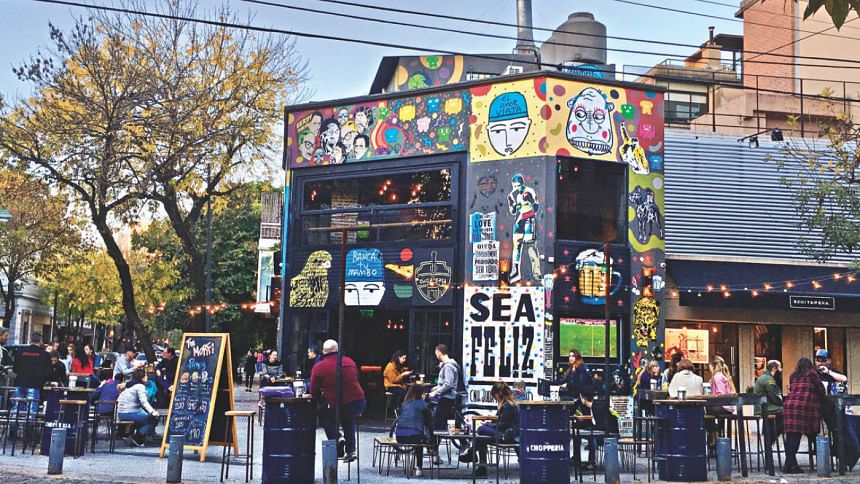
I had originally tried my hand at learning to speak French but failed spectacularly. So, I turned to Spanish, a seemingly more manageable language, where I could, at least, pronounce the words I was reading. Somewhere along the way, I decided I would move to Buenos Aires in Argentina for a more immersive learning experience. I suppose it was the lure of its rebellious but colourful past, the vibrant culture and of course, the famed Argentinian steak. The allure continued. My Spanish lessons, however, did not.
The stars aligned and I found myself staring at the prospect of living there, albeit for a very short period. Bags packed and an apartment sorted, we headed towards Buenos Aires. We had romantic notions of walking down wide, cobbled-stoned boulevards, surrounding ourselves with art and Latin American culture, wining and dining, and of course, writing about it all. What we got however, was a tempered, more child-friendly version of our visions, introducing us to a side of Buenos Aires we'd never imagined before.
Large and sprawling, Buenos Aires is home to a third of Argentina's population, offering a heady mix of classical European architecture and grungy, graffitied streets. We quickly realised that the city, (as with any large city I suppose), alters itself based on the barrio (neighbourhood) you're in. Sure you have some world class tourist attractions, but the true essence of Buenos Aires can only be felt when spending time in some of its diverse neighbourhoods, which range from posh, boutique lined pockets to crime-riddled hotspots. This is Buenos Aires, through my eyes.
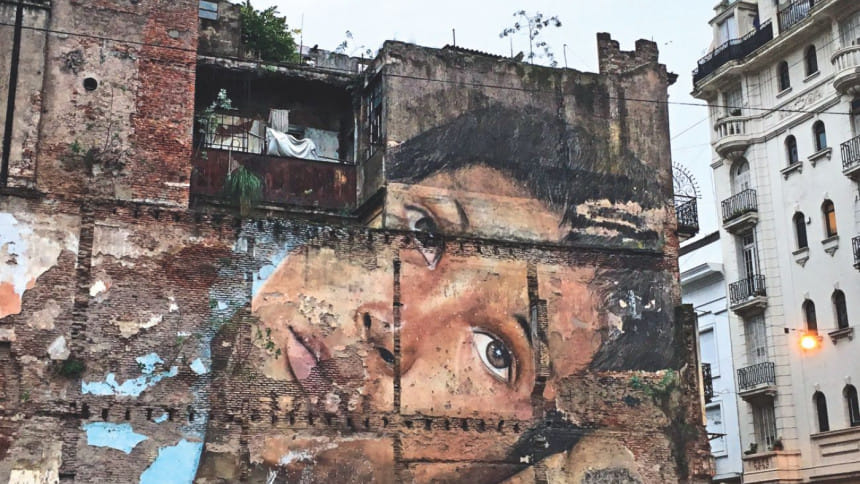
Plaza de Mayo
If I were to pick a focal point for the city, it would be the Plaza de Mayo. The square is not only the financial and administrative hub of the nation, it has also played a major role in the country's political history. The square is hemmed in by three prominent buildings: the whitewashed Cabildo, or City Hall and the former seat of the Colonial government, which has left a distinct imprint on its architecture; the Classical porticos at the Buenos Aires Metropolitan Cathedral, which, as the former parish of the current Pope draws in hordes of religious tourists; and the distinctive pink facades of the Casa Rosada, the government house, from where Evita gave her historic speech.
The focal point of the square itself is the May Pyramid, the first ever patriotic monument built in Argentina. Contrary to its name, the obelisk shaped monument has historically sheltered many a protest, and to this day, it remains the home of the Falklands War veterans' protest camp and the weekly march by the Madres de la Plaza de Mayo, or Mothers of the Disappeared. I jostled with suited professionals, hurriedly returning from lunch breaks, TV camera crews, protesters and even pigeons, to blend in with the crowds of camera toting tourists, my mind reeling from the onslaught of political history, unravelling before my very eyes.
What little I knew of Argentinian history came from the few books I had read, certainly not from lessons at school. Subsequently I had always felt my knowledge lacking. To be able to learn about it all first hand, in person, felt like the ultimate privilege. I found myself returning to this square on multiple occasions, trying to learn a bit more each time.
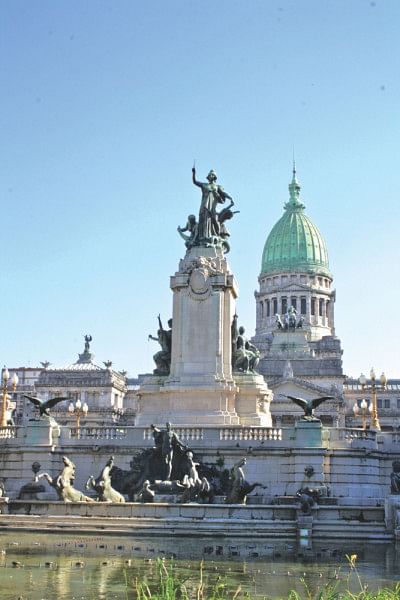
Avenida de Mayo
A stroll down Avenida de Mayo, took me past some of the best examples of the Classical architecture that Buenos Aires is famous for. Palacio Barolo, with its seemingly eccentric façade, was a standout. I must have spent hours trying to photograph its union of neo-Gothic and Classical elements, literally bending over backwards to frame its 100-meter tower. It is hard to believe that this impressive structure isn't home to royalty, but a mere office building.
When I wasn't gawping up at the buildings (and apologetically bumping into passers-by) on Avenida de Mayo, I was scouring the shopfronts for quirky antiques stores, historic cafes and my favourite, second-hand bookstores.
Buenos Aires may have been crowned the tango capital of the world, but it is well deserving of another accolade. The sheer number of second-hand bookshops strewn around the city is every bibliophiles dream. Some are housed in basements, teetering with piles of dusty tomes, while others are tucked away inside non-descript buildings. All come with the oddly tantalising smell of musty old paper. But alas, most featured Spanish titles, a language I had still not managed to come to grips with.
While one end of Avenida de Mayo is edged by the Plaza de Mayo, the other features the Palacio del Congreso, the Argentinian Congress. The impressive building, similar in style to the U.S. Congress, opens up to the Congressional Plaza which has also seen its fair share of protests, although these days it is mostly thronged by tourists lounging on its immaculately manicured lawns.
Avenida 9 de Julio
Another busy thoroughfare through the city, boasting wide avenues, Avenida 9 de Julio is loud and seemingly endless. Walking south amidst the bustle of city life, past offices, theatres and malls, I was met with two distinctive landmarks on the horizon. A tall, gleaming white obelisk rose up above the surrounding buildings, and beyond, the unmistakable features of Eva Perón or Evita, ardently speaking into a microphone. The latter, a steel image imprinted on the building housing the Ministry of Health, held an inexplicable appeal, one that I continually sought out when I was in the area, and one that I chose to photograph from every angle imaginable.
On my last day in Buenos Aires, as our taxi wound its way up Avenida 9 de Julio, I found myself staring up at Evita through the rain-speckled window, the sky dark and grey beyond - a wry reminder of a Hollywood ending.
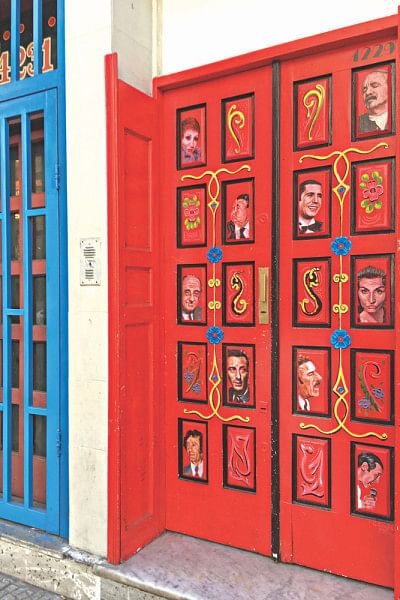
Palermo
The largest barrio in Buenos Aires, Palermo is as diverse as it is sprawling. Given its expanse, locals generally refer to the sub-divisions within this neighbourhood, the most prominent of which are Palermo Soho, Palermo Hollywood and Alto Palermo, each drawing an eclectic mix of porteños, expats and tourists.
Our quirky little apartment was meters away from the grassy patches of Parque Las Heras and the thriving Alto Palermo shopping mall. Close to shops and with a wide selection of parks for my rambunctious toddler, I still think of our apartment as home. Housed in an elegant 1920s building, it was the embodiment of Buenos Aires, adorned with vintage furniture and kitschy knickknacks, the likes of which are found in the many ferias (street markets) around the city – a perfect melange of old and new.
Even today, as I write this, I am visited by fond memories of our time in there. It's where I learnt to appreciate mate (popular South American drink, similar to green tea) and perfected the art of making one. It's where we tried our hand at Argentinian dishes and when homesick, whipped up Bangladeshi favourites using my carefully acquired spice supply in a city that lacked so many staples from a deshi pantry.
It's where we returned with our fat tubs of dulce de leche ice-cream, despite it being winter. It's where we learnt to shop around for the best deals and wave to the familiar shopkeepers who never failed to croon over my son. It's the place my son learnt to call home, in Spanish.
Neighbouring Palermo Soho was a short walk away, a barrio inundated by dining options and ferias. Hipster burger bars stood shoulder to shoulder with traditional parillas and hole-in-the-wall kebab shops and Colombian arepa dives. Come rain, hail or shine, the neighbourhood plazas would either play host to crafts markets or fresh food produce stalls. A few blocks over at Palermo Hollywood, the shops take on a more boutique feel, as do the modern steel and glass apartment buildings.
They say the nightlife in Palermo is electric. Not something we were able to put to the test given the toddler in tow. However, where we did find ourselves were the many parks of Palermo. Palermo is possibly the greenest barrio in Buenos Aires, with acres of land dedicated to parklands and playgrounds – one of numerous reasons why we were advised to settle there with our little one.
We were in close vicinity to the Botanical Gardens and Parque Las Heras, both large and noteworthy in themselves. However, mere 20-minute walk would bring us to Parque Tres de Febrero, an elaborate system of woods, lakes and parklands. For those rare times we walked into a park and didn't head straight for the slides, Parque Tres de Febrero offered landscaped gardens, delicately designed bridges and pagodas. While we're not folks who seek out aesthetic pleasures from manicured gardens, it didn't take an expert to relish in the beautiful surrounds and watch porteños go about their lives.
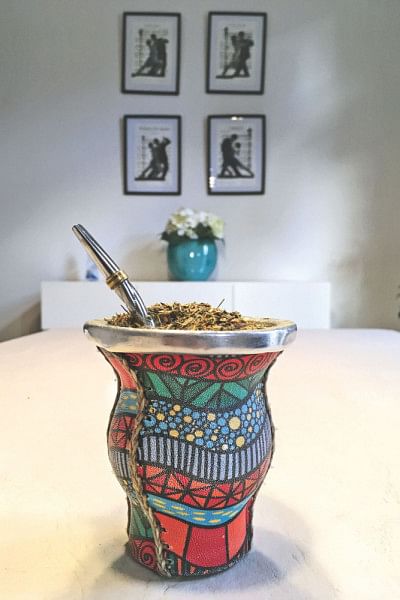
Recoleta
Neighbouring Recoleta imbues class and it is perhaps this barrio that has earned Buenos Aires the title "Paris of South America." Upmarket boutiques and Parisian-styled cafes slot themselves besides impressive embassies and mansions. Weekends witness the city's largest artisan market at Plaza Intendente Alvear, a labyrinth of makeshift stalls, art and crafts. However, what prompted me to return to Recoleta was its famous cemetery. Recoleta Cemetary is unlike any cemetery I have ever seen.
As I entered through the elaborate gates into the cemetery and walked through the avenue lined by crypts, only one word kept reverberating in my head: necropolis. And it is indeed akin to a vast city - only it belonged to the dead. Stretching over four city blocks and with over 6,400 mausoleums, Recoleta Cemetery is where Argentina's rich and famous lie in rest. It is also where Argentina's favourite First Lady, Eva Perón, popularly known as Evita, is buried. You only need to follow the retinue of tourists to find their family crypt, a relatively nondescript structure. Surrounding it are grandiose structures, some depicting Greek temples, others Gothic chapels. Bronze angels keep watch over the dead, marble Madonnas stand by, frozen in piety. Some of the mausoleums were crumbling, their entries obstructed by fallen masonry, while others sported gilded domes. As I raised my eyes upwards to take in some of the mammoth structures, I spied high-rise apartment buildings towering over the city of the dead. A contradiction that brought me crashing back to reality.
The catacomb of narrow alleyways and the leafy main thoroughfare all meet at the centre of the cemetery, marked by an obelisk topped by a condor. It reminded me of the Plaza de Mayo, the heart of Buenos Aires. The hearts here, however, had stopped beating.
Samai Haider is a writer, traveller, artist and... economist. If her rather odd amalgamation of interests isn't dotty enough, she is currently travelling around South America—with her pack and toddler strapped to her back. Read about the fables of her foibles here at Star Weekend. You can see more of her work at: http://samaihaider.com/

 For all latest news, follow The Daily Star's Google News channel.
For all latest news, follow The Daily Star's Google News channel. 



Comments